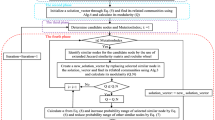Abstract
Community structure property is indispensable to discover the potential functionality of complex systems. Community detection (community discovery) is a technology for revealing the behavior of nodes aggregation in complex networks. To uncover the community structure of networks in a fast and effective way, in this paper, we propose a novel memetic algorithm called memetic algorithm with population learning (MAPL) based on the optimization of modularity. The proposed MAPL consists of a new initialization method, which can improve the population quality and accelerate the convergence of the algorithm to the optimal solutions, genetic operations and a local search using population learning to guide the direction of the optimization process. Extensive experiments on both synthetic networks and real-world networks demonstrate that compared with the five classic algorithms, the proposed MAPL has effective performance on discovering the community structure of complex networks.
Access this chapter
Tax calculation will be finalised at checkout
Purchases are for personal use only
Similar content being viewed by others
References
Watts, D.J., Strogatz, S.H.: Collective dynamics of ‘small-world’ networks. Nature 393(6684), 440–442 (1998)
Barabási, A.L., Albert, R.: Emergency of scaling in random networks. Science 286(5439), 509 (1999)
Rosvall, M., Bergstrom, C.T.: An information-theoretic framework for resolving community structure in complex networks. Proc. Natl. Acad. Sci. 104(18), 7327–7331 (2007)
Steinhaeuser, K., Chawla, N.V.: Identifying and evaluating community structure in complex networks. Pattern Recogn. Lett. 31(5), 413–421 (2010)
Li, Q., Zhong, J., Cao, Z., Wang, C.: Enhancing network embeddingwith implicit clustering, 452–467 (2019)
Moscato, V., Sperlì, G.: A survey about community detection over on-line social and heterogeneous information networks. Knowl. Based Syst. 224, 107112 (2021)
Chen, J., Wang, B., U.L.: Personal recommender system based on user interest community in social network model. Phys. A Stat. Mech. Appl. 526, 120961 (2019)
Newman, M.E.J., Girvan, M.: Finding a devaluating community structure innetworks. Phys. Rev. E 69(2), 026113 (2019)
Newman, M.E.J.: Fast algorithm for detecting community structure in networks. Phys. Rev. E 69(6), 066133 (2004)
Clauset, A., Newman, M.E.J., Moore, C.: Finding community structure in very large networks. Phy. Rev. E 70(6), 066111 (2004)
Pizzuti, C.: A genetic algorithm for community detection in social networks. In: Rudolph, G., Jansen, T., Beume, N., Lucas, S., Poloni, C. (eds.) PPSN 2008. LNCS, vol. 5199, pp. 1081–1090. Springer, Heidelberg (2008). https://doi.org/10.1007/978-3-540-87700-4_107
Gong, M., Fu, B., Jiao, L.: Memetic algorithm for community detection in networks. Phys. Rev. 84(5), 056101 (2011)
Pizzuti, C.: A multi-objective genetic algorithm to find communities in complex networks. IEEE Trans. Evol. Comput. 16(3), 418–430 (2012)
Gong, M., Ma, L., Zhang, Q.: Community detection in networks by using multiobjective evolutionary algorithm with decomposition. Physica A 391(15), 4050–4060 (2012)
Pizzuti, C.: A multiobjective genetic algorithm to find communities in complex networks. IEEE Trans. Evol. Comput. 16(3), 418–430 (2012)
Liang, S., Li, H., Gong, M.: Distributed multi-objective community detection in large-scale and complex networks, 201–205 (2019)
Danon, L., Diaz-Guilera, A., Duch, J., Arenas, A.: Comparing communitystructure identification. J. Stat. Mech. P09008 (2005)
Handl, J., Knowles, J.: An evolutionary approach to multiobjective clustering. IEEE Trans. Evol. Comput. 11(1), 56–76 (2007)
Chen, Y.C., Zhu, W.Y., Peng, W.C.: CIM: community-based influence maximization in social networks. ACM Trans. Intell. Syst. Technol. (TIST) 5(2), 25 (2014)
Lambiotte, R., Delvenne, J., Barahona,M.: Laplacian dynamics and multiscalemodular structure in networks. arXiv preprint arXiv:0812.1770 (2008)
Evans, T., Lambiotte, R.: Line graphs, link partitions, and overlappingcommunities. Phys. Rev. E 80, 016105 (2009)
Pizzuti, C.: A genetic algorithm for community detection in social networksparallel problem solving. Nature-PPSN X Springer, 1081–1090 (2008)
Tasgin, M., Bingol, H.: Community detection in complex networks using genetic algorithm. ArXiv Condensed Mattere-prints, 4419 (2006)
Girvan, M., Newman, M.E.J.: Community structure in social and biological networks. Proc. Natl. Acad. Sci. 99(12), 7821–7826 (2002)
Zachary, W.W.: An information flow model for conflict and fission in small groups. J. Anthropol. Res. 452–473 (1997)
Lusseau, D., Schneider, K., Boisseau, O.J.: The bottlenose dolphin community of doubtful sound features a large proportion of long-lasting associations. Behav. Ecol. Sociobiol. 54(4), 396–405 (2003)
Lancichinetti, A., Fortunato, S., Radicchi, F.: Benchmark graphs for testing community detection algorithms. Phys. Rev. E 78(4), 046110 (2008)
Acknowledgement
This work was supported by the National Natural Science Foundation of China (Grant No. 61703256, 61806119), Natural Science Basic Research Plan in Shaanxi Province of China (Program No. 2017JQ6070) and the Fundamental Research Funds for the Central Universities (Program No. GK201803020).
Author information
Authors and Affiliations
Corresponding author
Editor information
Editors and Affiliations
Rights and permissions
Copyright information
© 2021 Springer Nature Singapore Pte Ltd.
About this paper
Cite this paper
Sun, X., Sun, Y., Cheng, S., Bian, K., Liu, Z. (2021). Population Learning Based Memetic Algorithm for Community Detection in Complex Networks. In: Tan, Y., Shi, Y., Zomaya, A., Yan, H., Cai, J. (eds) Data Mining and Big Data. DMBD 2021. Communications in Computer and Information Science, vol 1454. Springer, Singapore. https://doi.org/10.1007/978-981-16-7502-7_29
Download citation
DOI: https://doi.org/10.1007/978-981-16-7502-7_29
Published:
Publisher Name: Springer, Singapore
Print ISBN: 978-981-16-7501-0
Online ISBN: 978-981-16-7502-7
eBook Packages: Computer ScienceComputer Science (R0)




